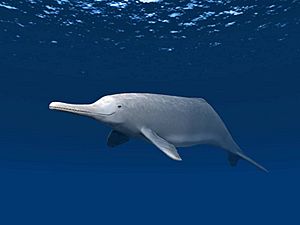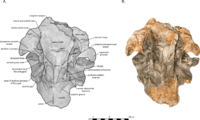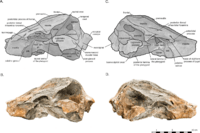Arktocara facts for kids
Quick facts for kids Arktocara |
|
|---|---|
 |
|
| Artistic reconstruction | |
| Scientific classification | |
| Genus: |
Arktocara
|
| Species: |
yakataga
|
Arktocara was an extinct type of river dolphin that lived in Alaska. It existed about 25 million years ago during the Oligocene epoch. Arktocara is special because it might be the oldest known modern toothed whale. It is also the most northern river dolphin ever found.
This ancient dolphin belonged to an extinct family called Allodelphinidae. Other members of this family included Allodelphis, Goedertius, Ninjadelphis, and Zarhinocetus. Arktocara was about 2.26 or 2.28 meters (7.4 or 7.5 ft) long. This is similar in size to its closest living relative, the South Asian river dolphin. However, Arktocara likely had a very long beak and neck, so it might have been even longer. Scientists only know about this animal from a skull that was partly preserved. Its way of life might have been similar to the modern Dall's porpoise. Its remains were found in the Poul Creek Formation in Alaska.
Contents
Discovering Arktocara
The only known fossil of Arktocara yakataga is an incomplete skull. A geologist named Donald J. Miller found it in 1951. He was mapping an area in Alaska called the Yakataga District. This is where the species name yakataga comes from. The name Arktocara comes from Ancient Greek words. Arktos means "north" and cara means "face," so it means "the face of the north." "Yakataga" means "canoe road" in the Tlingit language. This refers to the reefs that create a canoe path to a village.
Scientists from the Smithsonian, Alexandra Boersma and Nicholas Pyenson, officially described Arktocara in 2016. This was 65 years after the skull was first found. They recognized it as a brand new species.
| Platanistoidea | ||||||||||||||||||||||||||||||||||||||||||||||||||||||||||||||||||||||||||||||
|
||||||||||||||||||||||||||||||||||||||||||||||||||||||||||||||||||||||||||||||
| Relationships of Arktocara within Platanistoidea
Blue = Allodelphinidae |
Arktocara was a river dolphin in the superfamily Platanistoidea. It belonged to the extinct family Allodelphinidae. Today, the only living member of Platanistoidea is the South Asian river dolphin. This dolphin lives in warm, tropical rivers. The discovery of Arktocara helps scientists understand that these river dolphins likely first evolved in the oceans.
Arktocara shared some features with other platanistoid dolphins. These included a special bone in its ear and deep grooves on its beak. Its cranium (the part of the skull that holds the brain) was wide. It also had more than 25 teeth, and its back teeth had only one root.
What Arktocara Looked Like
Arktocara was estimated to be about 2.26 or 2.28 meters (7.4 or 7.5 ft) long. This size is similar to the modern-day South Asian river dolphin. That dolphin is about 2.4 meters (7.9 ft) long and weighs about 85 kilograms (187 lb). Based on other dolphins in its family, Arktocara likely had a very long beak. It also had a long neck, which is unusual for most dolphins. Most dolphins have short, fused neck bones. This long neck might have made Arktocara even longer than its estimated size.
Arktocara had some unique features compared to other platanistoid dolphins. It had a sagittal crest, which is a ridge on top of its skull. Its nostrils were positioned vertically. The bones around its eye sockets were also different. The front part of its head, between the eyes, was U-shaped. Scientists believe the skull belonged to an adult animal.
Life of Arktocara
Even though it's called a river dolphin, Arktocara probably lived in the ocean near the coast. Many ancient platanistoid dolphins lived in the ocean, not rivers. Scientists think its lifestyle and diet were similar to the modern Dall's porpoise. Dall's porpoises are hunters that eat fish and squid found from the surface down to deeper, darker waters.
Some scientists believe that ancient platanistoids like Arktocara faced competition from other dolphin groups in the ocean. This competition might have led them to move into rivers over time. However, this idea needs more research.
Ancient Environment of Arktocara
Arktocara lived in the subarctic waters of Alaska. Its fossils were found near the 60th parallel north. This makes it the most northern river dolphin known. Arktocara lived between 29 and 24 million years ago, during the Oligocene epoch. This time period was important for the evolution and variety of dolphins and whales.
Many other sea creatures lived alongside Arktocara in the Poul Creek Formation. These included different types of nautiluses, such as Aturia alaskensis. There were also various snails and clams.






